The 2015 MacBook Review
by Ryan Smith on April 14, 2015 10:15 AM EST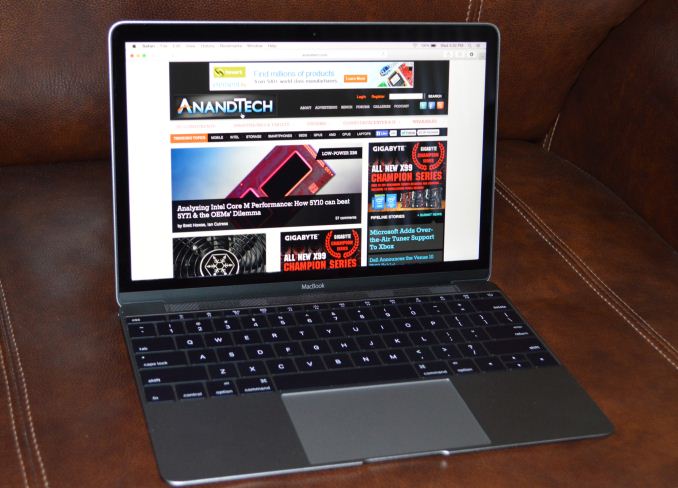
I’m still not entirely sure when it actually happened, but at some point over the last couple of years the crossover between tablets and laptops stopped being an idea and became a real thing. Perhaps it was Microsoft’s Surface Pro 3, which came out as an x86 Core architecture tablet that was finally thin enough to no longer be an awkward laptop without an attached keyboard. Or maybe it was the more recent release of Intel’s Core M family of CPUs, which brought the Core architecture to a sub-5W design for the first time while making the overall SoC thinner than ever before.
But either way you cut it, the line between tablets and laptops is blurrier than ever before. The performance of tablets is continuing to improve through faster CPUs and unexpectedly powerful GPUs, all the while laptops and high-performance x86 tablets are getting thinner, lighter, and lower power. There are still some important differences between the devices, and this is a consequence of both current technological limitations as well as design differences, but clearly the point where traditional tablets end and traditional laptops end is no longer a well-defined one.
This brings us to today’s review and today’s launch of Apple’s latest ultra-thin laptop, the simply named MacBook. Though Apple’s device is distinctly a laptop in terms of form factor and design, you’d none the less be excused for mistaking it for a large form factor tablet if you took a look at its overall size and internal configuration, both of which are far closer to a tablet than a laptop. Apple may not be doing any kind of wild 2-in-1 transforming design, or even pushing the concept of a touchscreen OS X device, but they have clearly tapped their immense experience with tablets in putting together the new MacBook.
The 2015 MacBook is an interesting take on building a Mac, one whose outward appearance hides just how much Apple has done under the hood to make it possible. Ostensibly the MacBook is an ultra-thin, ultra-light laptop, pushing beyond even the standards for Ultrabooks as first established by the MacBook Air. Retaining many of the qualities of Apple’s MacBook Air and Retina MacBook Pro lines, the MacBook delivers the Mac laptop experience in a device that is at its largest point just 1.31cm thick, and whose overall footprint is even smaller than the 11” MacBook Air, despite the fact that it includes a larger 12” screen.
From an end-user standpoint then the focus on the MacBook is going to be on its size, especially its thinness. It’s how Apple is choosing to promote it and it’s by far the laptop’s most distinctive attribute. At the same time however is the story of how Apple got to this point, and what trade-offs and sacrifices they had to make to get a laptop into this form factor. The laws of physics enforce a pretty clear trade-off between size and performance, so in creating the MacBook Apple has not only created a new size category of Macs, but a new performance category as well. It’s smaller than even the MacBook Air, but it also follows a different performance curve, and ultimately is targeted at a somewhat different user base than the now-traditional ultrabook.
| 2015 MacBook Lineup | ||||||
| MacBook Base (Model Tested) |
MacBook High-End |
MacBook Max Config. |
MacBook Air 11" (2015) | |||
| Dimensions |
H: 0.11-0.52" (0.35-1.31cm)
W: 11.04" (28.05cm) D: 7.74" (19.65cm) |
H: 0.11-0.68" (0.3-1.7cm)
W: 11.8" (30cm) D: 7.56" (19.2cm) |
||||
| Weight | 2.03 lbs (0.92kg) | 2.38 lbs (1.08kg) | ||||
| Base CPU Clock | 1.1 GHz Core M | 1.2 GHz Core M | 1.3 GHz Core M | 1.6GHz Core i5 | ||
| Max CPU Clock | 2.4GHz | 2.6GHz | 2.9GHz | 2.7GHz | ||
| GPU | Intel HD Graphics 5300 (GT2) | Intel HD Graphics 6000 (GT3) | ||||
| RAM | 8GB LPDDR3-1600 | 4GB LPDDR3-1600 | ||||
| SSD | 256GB PCIe SSD | 512GB PCIe SSD | 512GB PCIe SSD | 128GB PCIe SSD | ||
| Display | 12" 2304 x 1440 IPS LCD | 11.6" 1366x768 TN LCD | ||||
| Ports | 1 x USB 3.1 (Gen 1) Type-C, 3.5mm combo jack | 1x Thunderbolt 2, 2x USB 3.0 (Type-A), 3.5mm combo jack | ||||
| Networking | 2x2:2 802.11ac | 2x2:2 802.11ac | ||||
| Battery | 39.7 Wh | 38 Wh | ||||
| Price | $1299 | $1599 | $1749 | $899 | ||
We’ll get back to the MacBook’s design in a bit, but first let’s talk about specifications and pricing. With the MacBook Air having transitioned from Apple’s ultra-premium ultra-portable laptop to their entry-level ultra-portable laptop over the last few years – killing the original MacBook in the process – there has been a lot of demand for a premium MacBook Air, particularly one implementing a Retina display. In releasing the new MacBook Apple looks to be addressing at least some of those demands by finally putting together an ultra-portable laptop with just such a Retina display, but in the process they have also re-established the MacBook as a line of premium laptops, along of course with all the differences that come from making such a thin and light laptop.
This makes the new MacBook more expensive than the larger MacBook Airs, with the entry level MacBook starting at $1299, versus $899 for the 11” MacBook Air. What that $1299 gets you is access to the first of Apple’s laptops based on Intel’s Core M processor, which in turn is a big part of what has allowed Apple to make such a little laptop.
With Core M rated for a TDP of just 4.5W and only being 1.04mm thick, Intel geared their smallest Core processor towards larger format tablets and fanless laptops, with Apple tapping Core M specifically for the latter. Core M in turn is a reality through a combination of Intel’s new 14nm fabrication process and some very tight power and thermal controls to ensure that the processor doesn’t exceed the tolerances of the laptop it’s built around. Compared to Intel’s mainline Core i family, Core M is a very fast processor in short bursts but over longer period of times has to live within the confines of such a small device, which we’ll explore in greater depth in our look at the MacBook’s performance.
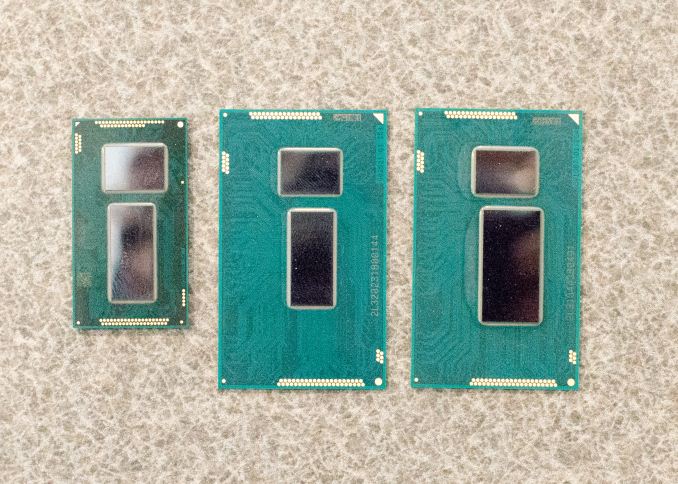 Core M/Broadwell-Y (left) vs Broadwell-U (center) vs Haswell-U (right)
Core M/Broadwell-Y (left) vs Broadwell-U (center) vs Haswell-U (right)
Overall Apple is offering 3 different versions of the Core M within the MacBook lineup. The $1299 base configuration utilizes a 1.1GHz Core M-5Y31, while the $1599 utilizes what we believe to be a 1.2GHz 5Y51. Finally, both configurations offer an optional upgrade to a faster processor, a 1.3GHz version of what’s likely the 5Y71, which is the fastest of Intel’s current Core M lineup. However to put a twist on things Apple has gone and clocked these processors slightly differently than Intel’s original specifications; all 3 MacBooks have a base clock higher than Intel’s specs, and in the case of the faster two these don’t even match Intel’s faster “cTDP Up” configurations. As a result the Core M processors in the new MacBook are somewhat unorthodox compared to the regular processors - and perhaps slightly more power hungry - though there’s nothing here that other OEMs couldn’t do as well.
Ideally Core M will spend very little time at its base clockspeeds, and will instead be turboing up to 2.4GHz, 2.6GHz, or 2.9GHz respectively. This vast divide between the base and turbo clocks reflects the performance-bursty nature of the Core M design, but it is also why the base clockspeeds that Apple advertises can be deceptively low. In light workloads where Core M can quickly reach its top speeds to complete a task, a 2.4GHz+ Core architecture processor is nothing short of zippy. However in sustained workloads these base clockspeeds become much more relevant, as Core M has to pull back to lower clockspeeds to keep heat and power consumption under control.
In any case, Apple has paired their first Core M laptop with some other very solid hardware, and thankfully in configurations much more befitting of a premium laptop than the MacBook Air’s anemic base specifications. No model of the MacBook comes with less than a 256GB PCIe-attached SSD, a welcome development for a company that has traditionally skimped on SSD capacities. Similarly the one (and only) RAM configuration is 8GB of LPDDR3, which all-told is not a massive amount, but is more than plenty for the kind of device Apple is building towards.
Compared to the 128GB SSD and 4GB of RAM in the base MacBook Airs, this is the first ultra-portable Mac in a while where I can say even the base model feels properly equipped. At the very least users shouldn’t be struggling with RAM or SSD capacity for some time. Meanwhile given the fact that the equivalent upgrade of an 11” MacBook air would be $300 – bringing the total price to $1199 – this means that while the MacBook is still more expensive than a MacBook Air, the difference isn’t nearly as wide as it would first seem.
Rounding out the MacBook’s build are a few firsts for Apple. The MacBook’s 12” 2304x1440 Retina IPS display is the first Retina IPS display in an Apple ultra-portable, and quite the sight to behold. Meanwhile the MacBook is also the first Mac to come equipped with the new USB Type-C port, similarly small and fully reversible. Both of these help to cement the MacBook’s place as a cutting-edge Mac, similar to the Retina MacBook Pro’s position in 2012 when it was launched.


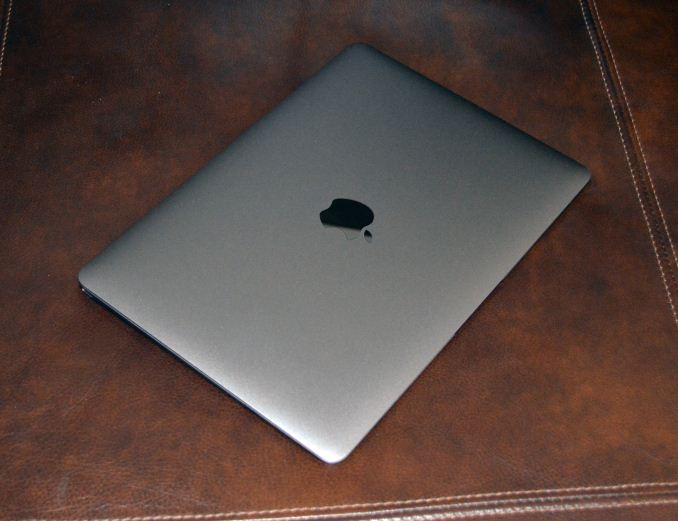
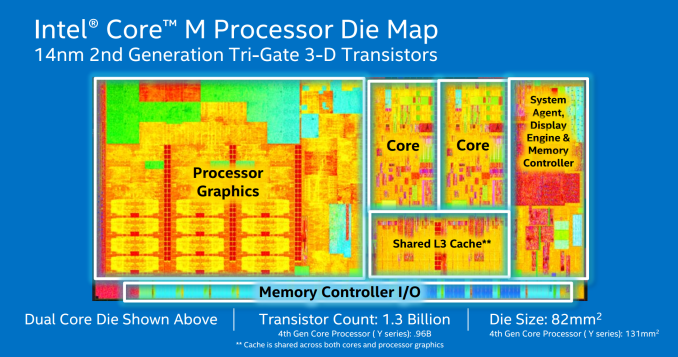
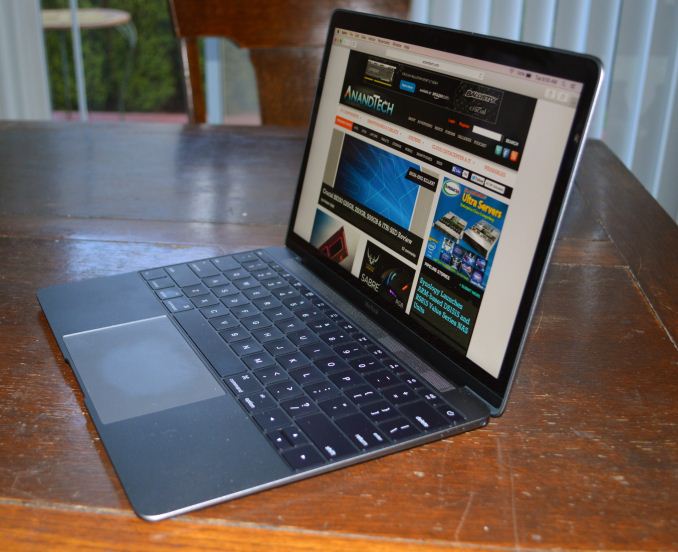








354 Comments
View All Comments
darkich - Wednesday, April 15, 2015 - link
Oh Anandtech, it is blatantly obvious that you do everything you can to twist reality in favor of your sponsor (Intel).So MacBook has a twice better GPU than iPad Air 2?
Why didn't you used a *graphics* category to explain that fact?
Why didn't you ran Manhattan or T Rex and showed the respective scores?
iLovefloss - Wednesday, April 15, 2015 - link
They linked to a more comprehensive Core M review in the article. If you actually read the damn thing rather than trying to accuse people of being sellouts, then you maybe you'd caught that.Shit, the only thing more annoying than a social media (anti-)SJ conversation is tech websites review comments. Everybody is a sellout.
narcaz - Wednesday, April 15, 2015 - link
I am sorry, but i think this one of the of the more mediocre reviews from Anandtech:"Compared to the 128GB SSD and 4GB of RAM in the base MacBook Airs, this is the first ultra-portable Mac in a while where I can say even the base model feels properly equipped. At the very least users shouldn’t be struggling with RAM or SSD capacity for some time. Meanwhile given the fact that the equivalent upgrade of an 11” MacBook air would be $300 – bringing the total price to $1199 – this means that while the MacBook is still more expensive than a MacBook Air, the difference isn’t nearly as wide as it would first seem."
Copy paste from Apple's marketing? The difference is as wide as it would first seem when you look at the trade-off. Compared to the MBA you get better portability and a retina screen. But you loose connectivity, battery life, hd camera, magsafe, cpu/gpu performance. And according to your defined target audience (second device buyers) buying these upgrades doesn't make much sense. It is ok that the 12'' MB is expensive, but don't try to argue around this fact.
"As far as desktop performance goes, we haven’t found any major problems for the MacBook’s Intel HD Graphics 5300 GPU. Even with Core M’s power limits it doesn’t show any issues holding 60fps at the default virtual resolution of 1280 x 800, though I would not suggest going any higher unless it’s necessary."
I had the impression that higher resolutions don't work very well on the 12'' MB models in the Apple store. It felt like the first 13'' rMBP: more screen space, but a bit laggy. The performance of the HD 4000 wasn't good enough and took another hit with Yosemite (especially when connected to a second display). I am not willing to invest in a MB, which isn't future proof for at least 2-3 years. The same is true for the potential lack of 4K/60hz. I hoped for more depth in this area.
The review could have been more critical about the 1 USB C Port. If it breaks you can't even charge your machine anymore and out of warranty services are extremely expensive. But i think the comments discussed this point to death. Thanks for the extra remarks about the sustained performance in the comments and please put this in the review and maybe do more tests.
wave84 - Wednesday, April 15, 2015 - link
I don't really think the Macbook is expensive. This is actually useable as a main computer for a lot of users (journalists, web designers, web programmers, etc). It will do just fine, as long as you have 8GB RAM and 256 for storage, which you get.You lose some stuff indeed, but for 100 bucks you get retina screen, extreme portability, and most important of all, it's fanless and completely silent. This is a huge quality of life improvement which no review will take into account.
Also, i do not believe the port to be an issue. Either you are docked, so you have plenty of ports (and you only unplug one cable), either you are mobile, when one port is enough for 99% of use cases.
I am very close to buying it. Still waiting for some upgraded CPU numbers.
narcaz - Wednesday, April 15, 2015 - link
I am looking for a second device besides my 15'' rMBP. The iPad doesn't cut it anymore. But 1279$ + 79$ (needed for occasional presentation) is expensive compared to the 11'' MBA 899$+29$. Impossible to sugarcoat it. It looks like Apple's upselling strategy got you on the hook. You can rationalize this purchase as much as you want, but i don't want to pay for upgrades, which i don't need. If you value portability and retina screen fine, enjoy it, but this doesn't make it a very good deal.Even in the Apple ecosystem the single port is problematic. Airplay Screen Mirroring suffers from lags, iCloud Photo Library is cumbersome and there is no backup solution while being on the road. Cables aren't dead. I think the next version will have second port.
telsin - Wednesday, April 15, 2015 - link
I'm curious to see if a newer hardware revision of the Apple TV that they're likely to announce at WWDC resolves some of the airplay lag. That thing is still using an A5 processor, whereas the latest iphones are up to A8 (huge difference in CPU/GPU performance). I too found airplay rather obnoxious when I tried it. In OSX, you can have it treat an airplay target as a second monitor, but it really kind of sucks unless you're just putting something there to read as a static document.bogda - Wednesday, April 15, 2015 - link
Now, make MacBook Air with the same quality screen, smaller bezel (like on this MacBook) and keyboard that stretches from edge to edge (like on this MacBook) and I might actually switch from PC to Mac.Mushin - Wednesday, April 15, 2015 - link
As for the SSD which is only connected through PCIe 2.0 that is a limitation of Core M see:http://ark.intel.com/products/84666/Intel-Core-M-5...
cknobman - Wednesday, April 15, 2015 - link
All I can say is ehh.Sure its built nice and a super small form factor
BUT
Price is high, performance is just OK, and battery life is frankly underwhelming. Sure the battery life is not terrible but given the hype over the Core M I was expecting better battery life.
Still no touch screen and it is still confined to the limitations of a laptop.
The benefit of small underpowered devices like this should lie in their ability to serve multiple purposes easily and change form factors.
If I still have to use it like a laptop (IE: open it up, type on a keyboard) and pay such a high price then I may as well go get a laptop with more power and better battery life.
For this price I'd still rather have something like a Surface Pro 3. With its ability to serve multiple purposes I can use it like a tablet or a laptop, get better battery life, and get a touch screen. All while paying less.
nerd1 - Wednesday, April 15, 2015 - link
Sp3 is lighter, thinner, more powerful, has more ports, has more input methods and even cheaper.